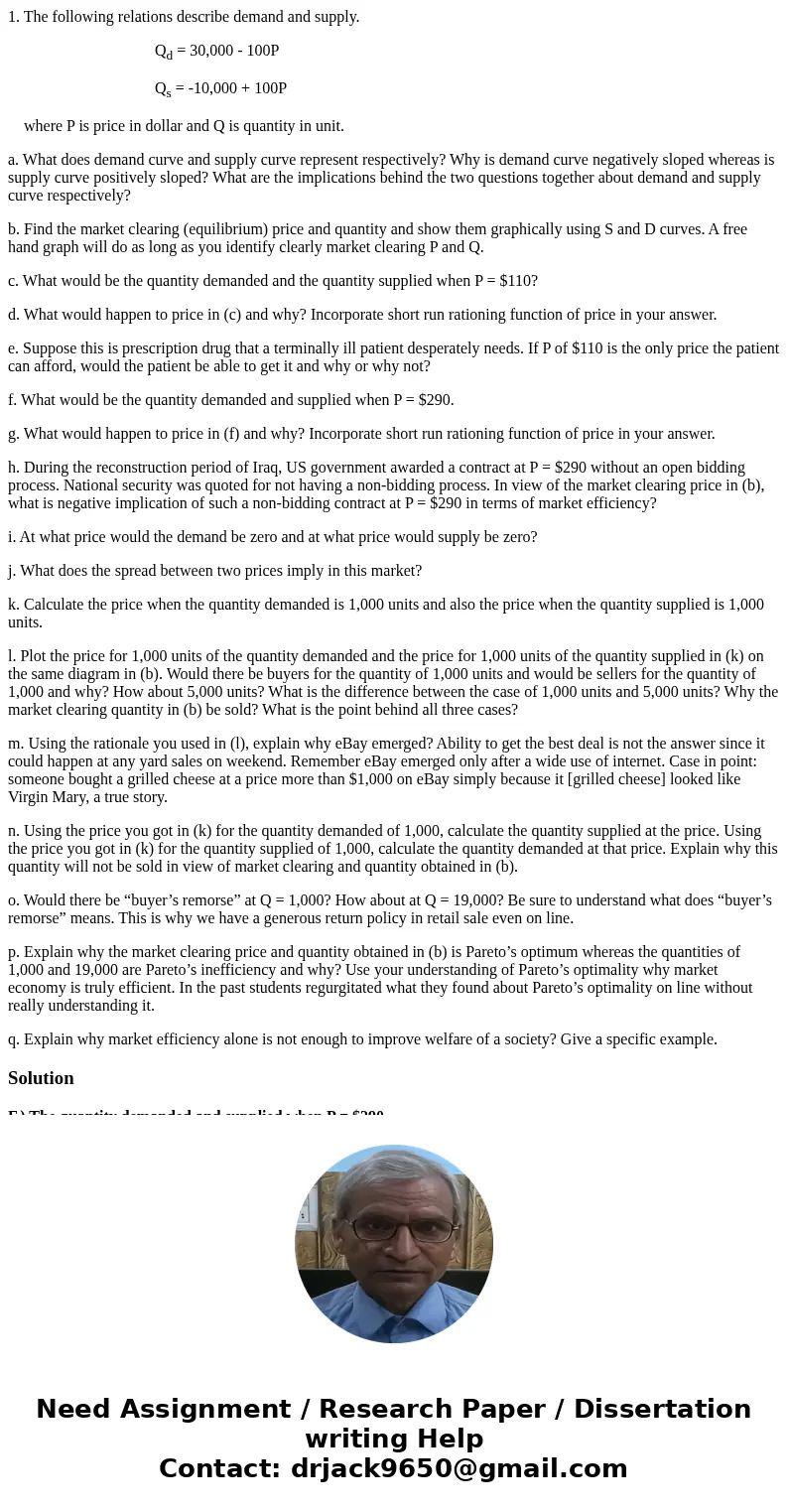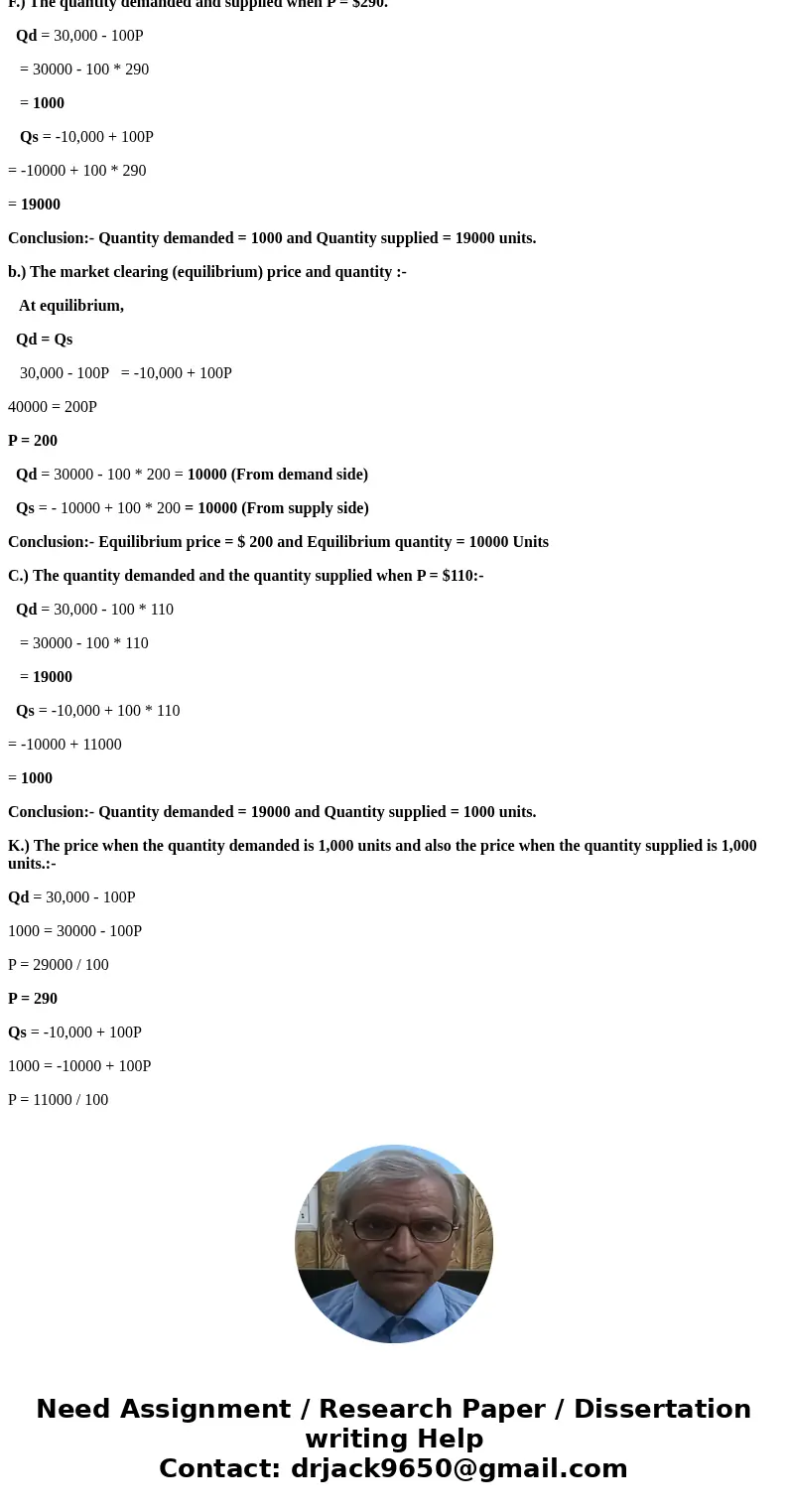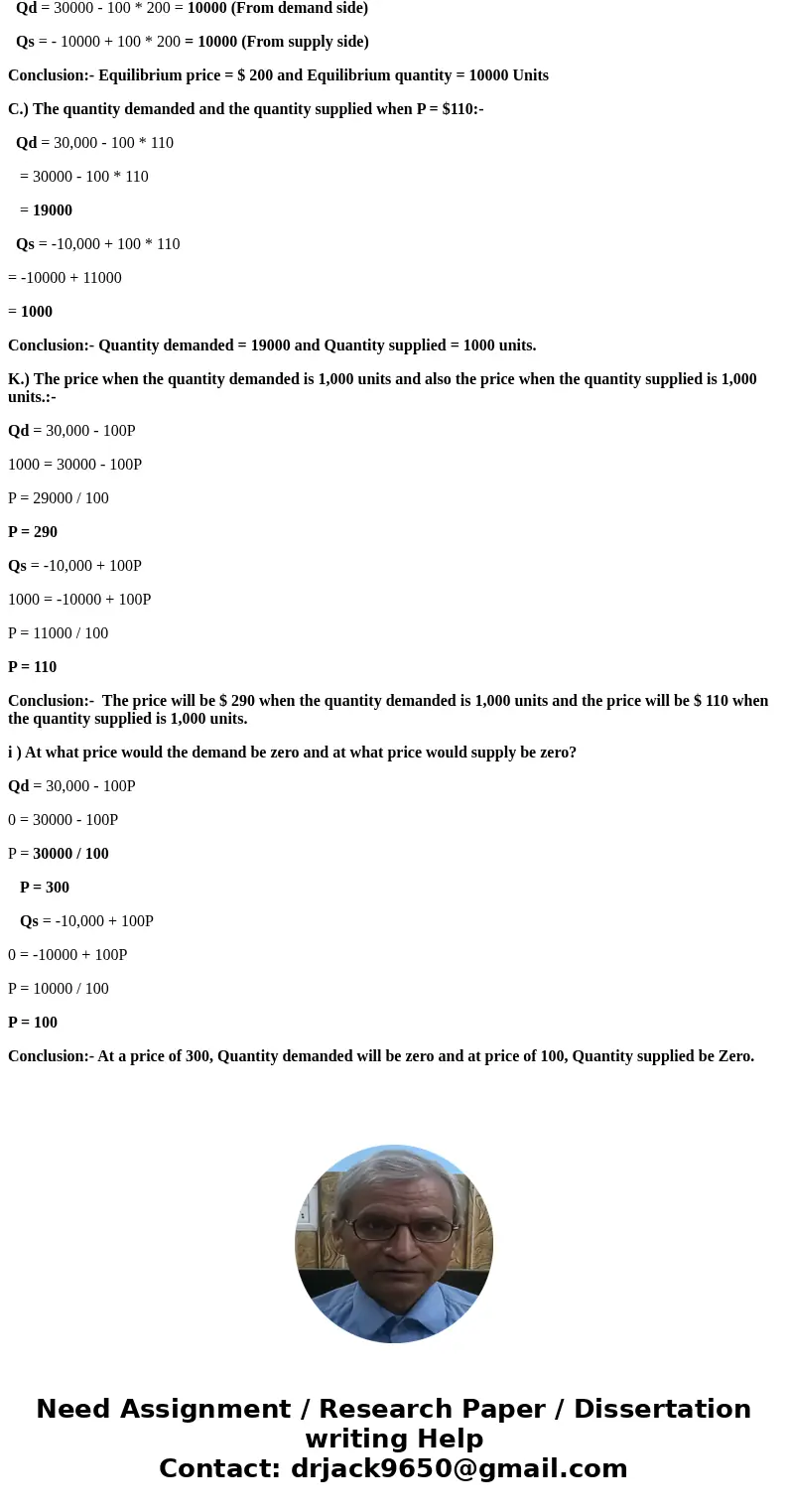1 The following relations describe demand and supply Qd 300
1. The following relations describe demand and supply.
Qd = 30,000 - 100P
Qs = -10,000 + 100P
where P is price in dollar and Q is quantity in unit.
a. What does demand curve and supply curve represent respectively? Why is demand curve negatively sloped whereas is supply curve positively sloped? What are the implications behind the two questions together about demand and supply curve respectively?
b. Find the market clearing (equilibrium) price and quantity and show them graphically using S and D curves. A free hand graph will do as long as you identify clearly market clearing P and Q.
c. What would be the quantity demanded and the quantity supplied when P = $110?
d. What would happen to price in (c) and why? Incorporate short run rationing function of price in your answer.
e. Suppose this is prescription drug that a terminally ill patient desperately needs. If P of $110 is the only price the patient can afford, would the patient be able to get it and why or why not?
f. What would be the quantity demanded and supplied when P = $290.
g. What would happen to price in (f) and why? Incorporate short run rationing function of price in your answer.
h. During the reconstruction period of Iraq, US government awarded a contract at P = $290 without an open bidding process. National security was quoted for not having a non-bidding process. In view of the market clearing price in (b), what is negative implication of such a non-bidding contract at P = $290 in terms of market efficiency?
i. At what price would the demand be zero and at what price would supply be zero?
j. What does the spread between two prices imply in this market?
k. Calculate the price when the quantity demanded is 1,000 units and also the price when the quantity supplied is 1,000 units.
l. Plot the price for 1,000 units of the quantity demanded and the price for 1,000 units of the quantity supplied in (k) on the same diagram in (b). Would there be buyers for the quantity of 1,000 units and would be sellers for the quantity of 1,000 and why? How about 5,000 units? What is the difference between the case of 1,000 units and 5,000 units? Why the market clearing quantity in (b) be sold? What is the point behind all three cases?
m. Using the rationale you used in (l), explain why eBay emerged? Ability to get the best deal is not the answer since it could happen at any yard sales on weekend. Remember eBay emerged only after a wide use of internet. Case in point: someone bought a grilled cheese at a price more than $1,000 on eBay simply because it [grilled cheese] looked like Virgin Mary, a true story.
n. Using the price you got in (k) for the quantity demanded of 1,000, calculate the quantity supplied at the price. Using the price you got in (k) for the quantity supplied of 1,000, calculate the quantity demanded at that price. Explain why this quantity will not be sold in view of market clearing and quantity obtained in (b).
o. Would there be “buyer’s remorse” at Q = 1,000? How about at Q = 19,000? Be sure to understand what does “buyer’s remorse” means. This is why we have a generous return policy in retail sale even on line.
p. Explain why the market clearing price and quantity obtained in (b) is Pareto’s optimum whereas the quantities of 1,000 and 19,000 are Pareto’s inefficiency and why? Use your understanding of Pareto’s optimality why market economy is truly efficient. In the past students regurgitated what they found about Pareto’s optimality on line without really understanding it.
q. Explain why market efficiency alone is not enough to improve welfare of a society? Give a specific example.
Solution
F.) The quantity demanded and supplied when P = $290.
Qd = 30,000 - 100P
= 30000 - 100 * 290
= 1000
Qs = -10,000 + 100P
= -10000 + 100 * 290
= 19000
Conclusion:- Quantity demanded = 1000 and Quantity supplied = 19000 units.
b.) The market clearing (equilibrium) price and quantity :-
At equilibrium,
Qd = Qs
30,000 - 100P = -10,000 + 100P
40000 = 200P
P = 200
Qd = 30000 - 100 * 200 = 10000 (From demand side)
Qs = - 10000 + 100 * 200 = 10000 (From supply side)
Conclusion:- Equilibrium price = $ 200 and Equilibrium quantity = 10000 Units
C.) The quantity demanded and the quantity supplied when P = $110:-
Qd = 30,000 - 100 * 110
= 30000 - 100 * 110
= 19000
Qs = -10,000 + 100 * 110
= -10000 + 11000
= 1000
Conclusion:- Quantity demanded = 19000 and Quantity supplied = 1000 units.
K.) The price when the quantity demanded is 1,000 units and also the price when the quantity supplied is 1,000 units.:-
Qd = 30,000 - 100P
1000 = 30000 - 100P
P = 29000 / 100
P = 290
Qs = -10,000 + 100P
1000 = -10000 + 100P
P = 11000 / 100
P = 110
Conclusion:- The price will be $ 290 when the quantity demanded is 1,000 units and the price will be $ 110 when the quantity supplied is 1,000 units.
i ) At what price would the demand be zero and at what price would supply be zero?
Qd = 30,000 - 100P
0 = 30000 - 100P
P = 30000 / 100
P = 300
Qs = -10,000 + 100P
0 = -10000 + 100P
P = 10000 / 100
P = 100
Conclusion:- At a price of 300, Quantity demanded will be zero and at price of 100, Quantity supplied be Zero.



 Homework Sourse
Homework Sourse